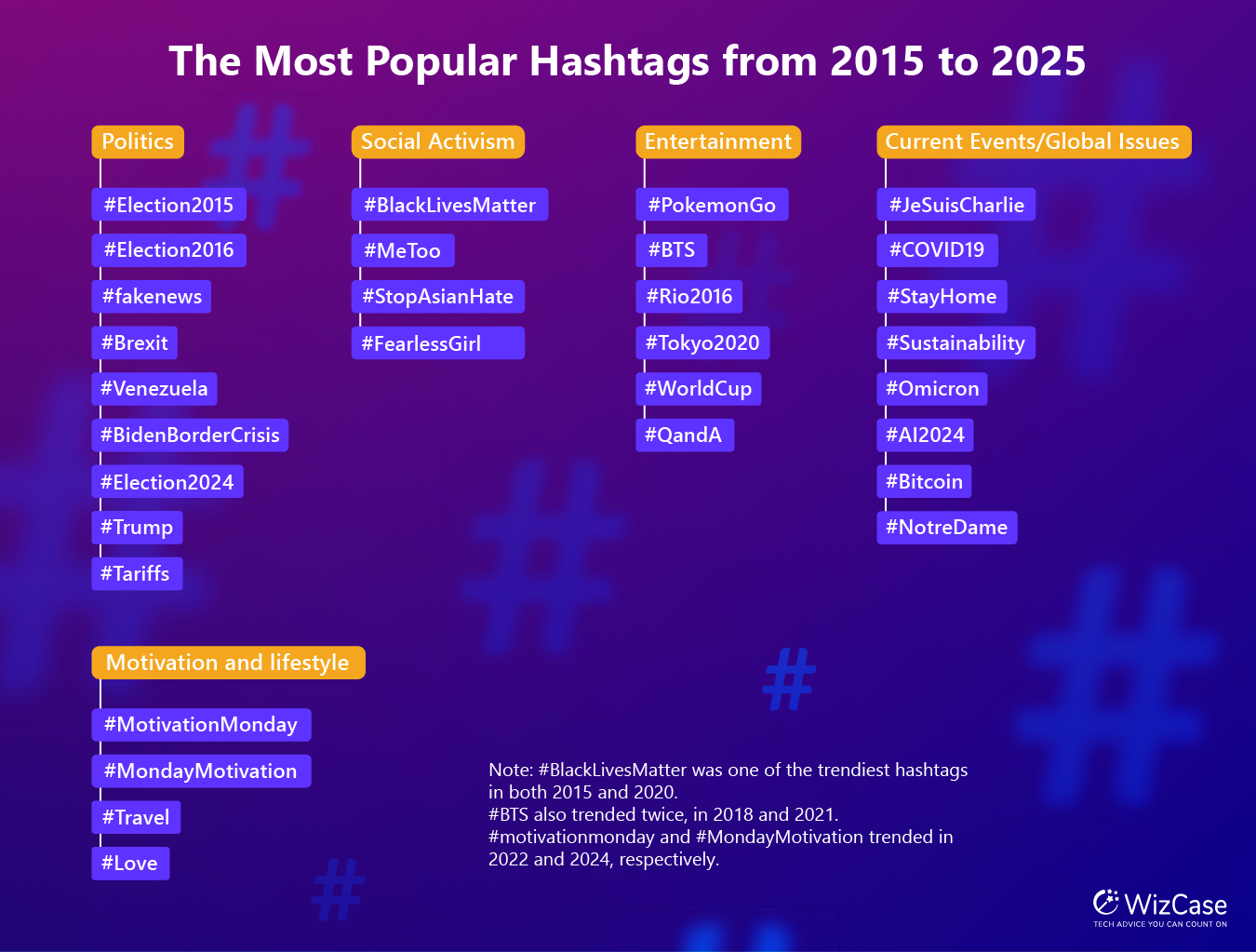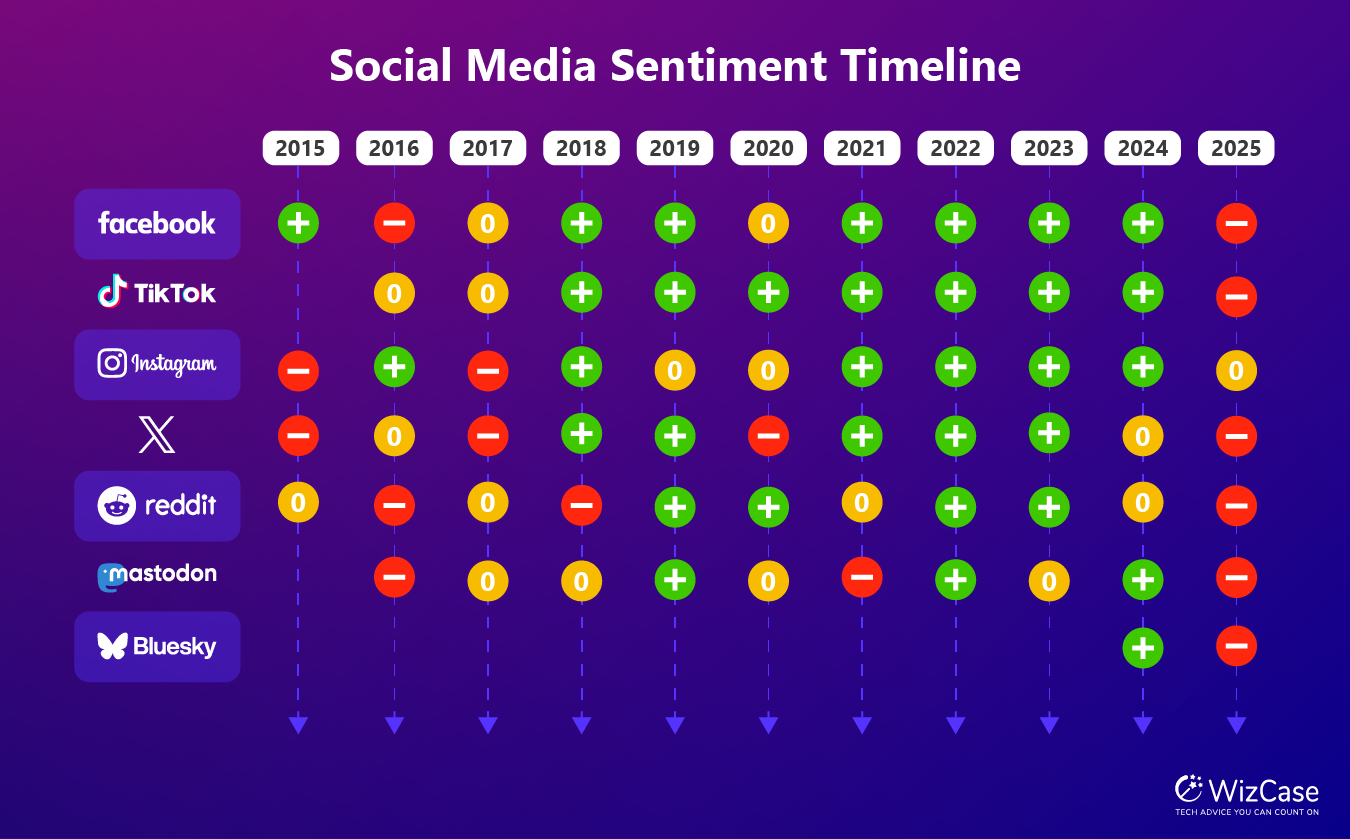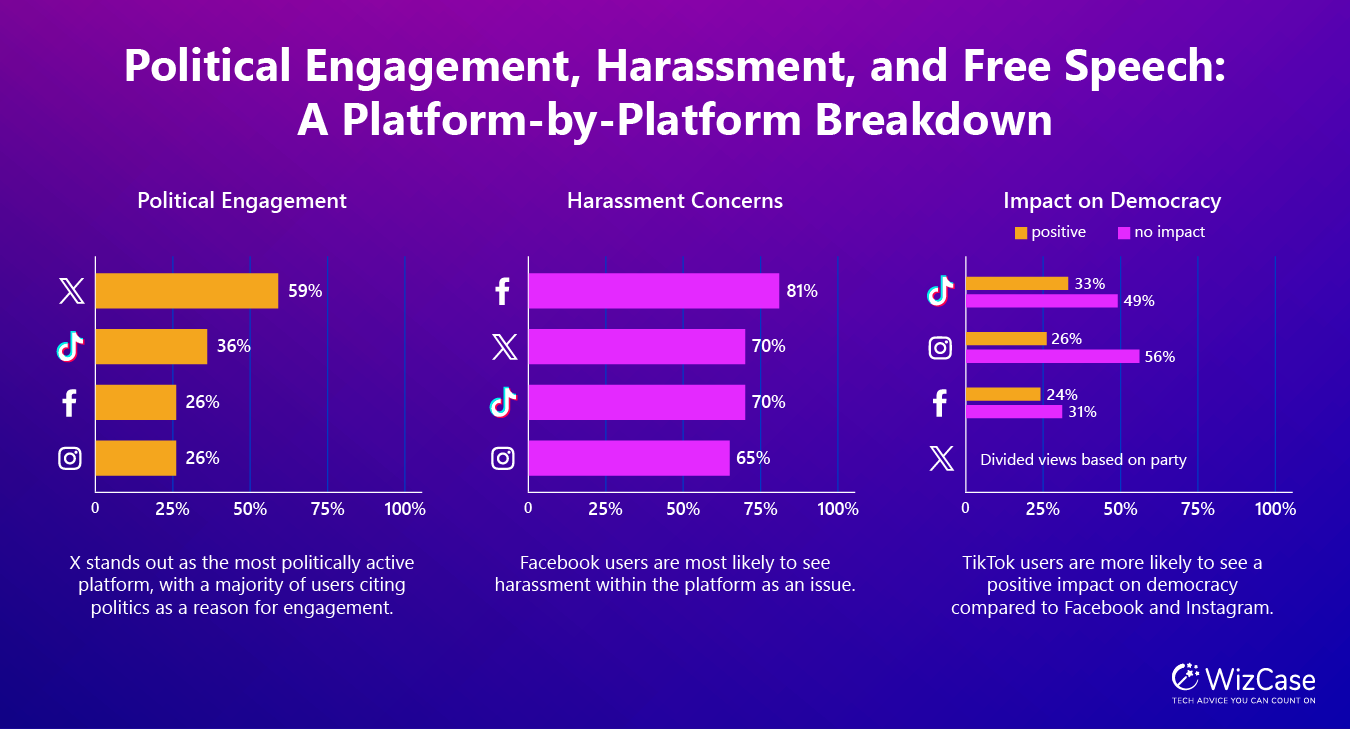Which Social Media Platforms Are the Most Positive and Negative? A 10-Year Sentiment Analysis
Key Takeaways
- With an overall score of 12%, Facebook has the highest sentiment average of all platforms in this research, making it the most positive social media platform.
- Mastodon garnered a higher negative sentiment than all other platforms in our research (-5%), likely due to polarizing discussions on posts with political hashtags.
- X is the most politically active platform, with 59% of users saying keeping up with politics is the main reason they use it.
- Over 70% of Facebook and Instagram users prioritize non-political reasons, like entertainment and family connections, over political engagement.
- Approximately 75% of U.S. adults who have experienced some form of harassment say it happened on a social media site.
Introduction
Social media is a powerful tool for connection, expression, and information sharing, but not all platforms make us feel the same way. Some are seemingly filled with positive interactions, while others can often seem overwhelming or negative. Have you ever wondered why certain platforms “feel happier” than others?
We at WizCase wondered about it too, so we decided to examine 10 years of sentiment data across the most popular social media platforms. By analyzing changes over the past decade, we discovered key trends that explain what factors have shaped these shifts in sentiment.
Which Platforms Are the Most Positive and Negative?
For this analysis, we selected seven platforms:
We then picked out the three most prominent hashtags per year, based on their popularity and relevance in social media during the 2015-2025 period. For example, in 2017, the #MeToo hashtag gained the most widespread traction, reflecting the popularity of the global movement against sexual abuse and harassment.
To analyze which types of discussions garnered the most positive or negative sentiment, we first classified the hashtags into different categories, such as “politics” or “social activism”. You can see the full lists in the image below.
We aimed at gathering 5 posts with each hashtag for further analysis. This would ideally result in 15 posts per platform per year, or 165 posts in total. However, this number varied, as some platforms were created after 2015 or lacked content with a specific hashtag.
For instance, Bluesky launched in 2023, so we only found 30 posts that were relevant for our study. Platforms like Facebook, Instagram, or X, on the other hand, had a lot more content available for analysis.
We used a sentiment analysis tool capable of processing historical data and handling multilingual content. Based on the result, each post was classified as positive (+1 point), neutral (0 points), or negative (-1 point). To evaluate the overall sentiment of a hashtag, we aggregated the scores of all posts associated with that hashtag.
For example, let’s take the 5 Facebook posts we selected with the #fakenews hashtag. Considering 2 of the posts are neutral, 2 are negative, and 1 is positive, this hashtag was categorized as garnering a negative sentiment (0 + 0 − 1 − 1 + 1 = −1). Since this was calculated based on 5 posts, the overall score for this hashtag is −20% (−1* (100% / 5) = −20%).
For our Facebook sentiment analysis, we looked into 165 posts in total (5 posts per each of the 33 most popular hashtags since 2015). In this instance, we found the vast majority of the posts to be neutral — only 36 have a positive sentiment, while 16 can be categorized as negative.
With an overall score of 12%, Facebook has the highest positive sentiment average of all platforms in this research.
Hashtags like #love and #MotivationMonday seem to be widely used to foster positivity and community support on Facebook. Other hashtags that prompt positive discussions are central to movements addressing social justice and equality, such as #StopAsianHate and #FearlessGirl.
On the other hand, politics and global issues dominate negative sentiment discussions on Facebook. Hashtags like #Venezuela, #Bitcoin, and #PokemonGo shows negative sentiment (-40%), reflecting concerns over economic crises, environmental impacts, and privacy issues.
Of the 165 Instagram posts analyzed, 35 have a positive sentiment while 17 are negative, with the remaining considered neutral. With an overall score of 11%, Instagram has the second-highest positive sentiment after Facebook.
The highest positive sentiment on Instagram is primarily evoked by discussions on lifestyle and entertainment topics, with hashtags like #MondayMotivation, #love, and #BTS dominating this space.
Negative sentiment is most prominent when it comes to social activism, where hashtags like #FearlessGirl, #BlackLivesMatter, and #MeToo highlight divisive and sensitive issues. A notable exception is #StopAsianHate, as 5 out of 5 Instagram posts with this hashtag were categorized as positive.
TikTok
Unfortunately, we couldn’t find all of our target posts on TikTok. The platform didn’t come out to the international market until 2017. So, some of the most popular hashtags for 2015-2017 didn’t turn up any results, and a couple (#Rio2016 and #QandA) were only found in a post or two.
Of the 123 TikTok posts we analyzed, 34 are positive; 17, negative; and 72, neutral. This brings in an overall sentiment of 10%.
Like in the two platforms above, discussions around motivation and lifestyle evoke the highest positive sentiment on TikTok. Entertainment — be it music- or sports-related — also generates strong positive sentiment, particularly hashtags like #BTS and #WorldCup.
Unlike in Instagram, where they garnered negative sentiments, social activism hashtags (such as #BlackLivesMatter and #MeToo) often evoke positive sentiment on TikTok. The posts on this platform tend to focus on empowerment and solidarity.
As is the case with most other platforms, negative sentiment on TikTok is most prevalent in discussions related to politics and current events. For instance, 4 out of 5 TikTok posts with #Tariffs were categorized as negative.
#Omicron (a COVID-19 variant) and #AI2024 (discussions around artificial intelligence) also exhibit negative sentiment, reflecting public anxiety and skepticism about health crises and technological advancements.
X (Formerly Twitter)
For our X sentiment analysis, we looked into 165 posts in total, 35 of which are positive; 31, negative; and 99, neutral. Based on these metrics, X earned an overall score of 2%, reflecting a combination of neutral and critical discussions, while still trending slightly positive.
Aside from motivational posts, positive sentiment on X is primarily driven by entertainment (#WorldCup, #Tokyo2020, #QandA) and some current events (#AI2024, #NotreDame, #JeSuisCharlie).
X is the only platform where discussions surrounding #MondayMotivation and #BTS had a negative sentiment. Interestingly, the almost identical #motivationmonday hashtag, which trended in 2022, evoked positive emotion.
Negative sentiment is most prevalent when it comes to politics. For instance, #Election2015 has a -60% overall score, reflecting contentious political discussions. Similarly, #Trump and #Tariffs also show significant negativity. In fact, the only political hashtag that garnered a positive sentiment was #Brexit.
Like with TikTok, it proved difficult to find all the target posts for our study on Reddit. We couldn’t find any posts for some of the hashtags (#Brexit, #AI2024, #QandA, and #bidenbordercrisis), and found fewer posts than intended for some others.
All in all, we analyzed 135 Reddit threads — 29 (21.5%) of which were categorized as positive and 27(20%) as negative. Based on these numbers, Reddit got an overall score of 2%, which reflects a slightly positive tilt in a dataset dominated by neutral posts.
Positive threads on Reddit tend to include motivation, lifestyle, and social activism hashtags such as #love and #BlackLivesMatter. On the other hand, politics-related hashtags dominate the negative sentiment category, with #Trump leading at -60% and #Election2016 at -33%.
However, some hashtags defied expectations. For instance, #Venezuela evoked positive emotion despite its political nature. Furthermore, although they typically evoke excitement, none of the hashtags we selected for the entertainment category garnered positive sentiment. This could be due to disappointments or controversies surrounding the events.
Bluesky
As we mentioned above, Bluesky was launched in 2023, so we could only gather 30 posts for our sentiment analysis — the smallest number of all platforms. Of those, 5 are positive, another 5 are negative, and the remaining 20 belong to the neutral category.
Bluesky lets users decide what they see instead of relying on algorithms. This means that users share or discuss topics without the platform pushing emotional content.
Equal numbers of positive and negative posts suggest mixed opinions tied to political and tech-related hashtags, including #AI2024 and #Trump. However, with only 30 posts analyzed, the sample is too small to draw definitive conclusions.
Mastodon
Although Mastodon launched in 2016, it didn’t have as much content available for analysis as some of the other platforms included in this research. We only found 56 relevant posts in total. A few of those (9) are positive, while a few others (8) are negative.
This is the only platform in our research with a negative overall score (-5%), which could be influenced by polarizing discussions on political issues like #Election2016, #Trump, or #Tariffs.
The positive sentiment landscape on Mastodon is a bit more varied, whereas negative sentiment is prominently associated with political and social activism hashtags. For instance, #Election2016 and #StopAsianHate both show a -100% sentiment, reflecting emotionally charged discussions around these two issues.
How Sentiment Has Changed Over Time (2015–2025)
Sentiment on social media has undergone significant shifts since 2015, reflecting broader societal changes and events.
Back in 2015-2017, the most predominant hashtags were mostly about social activism (#BlackLivesMatter, #MeToo, #FearlessGirl) and politics (#Election2015, #Election2016, #fakenewss), which prompted emotionally charged discussions on social media platforms, particularly on X and Reddit.
Things took a turn in 2018-2019, with a tendency towards positive posts around entertainment (#WorldCup, #BTS) and political issues (#Brexit, #Venezuela). In 2020, it all came down with hashtags like #COVID19, #StayHome, and #BlackLivesMatter hogging the spotlight.
This resulted in the overall sentiment on X being negative for the first time since 2017. At the same time, platforms that tend to have a more positive discourse, like Facebook and Instagram, remained neutral that year.
As the pandemic restrictions started letting up in 2021, discussions seemed to take on a positive turn again. Motivational hashtags (#love, #travel, #MondayMotivation) started trending, and people were commenting on entertainment events (#BTS, #Tokyo2020) and new developments (#sustainability, #omicron, #AI2024) with a seemingly more positive outlook.
Interestingly, 2022 is the only year when all social media platforms had a positive overall sentiment. This could be related to top trending hashtags being #motivationmonday and #Sustainability, which are usually associated with positive content.
However, so far in 2025, it seems like we’re taking a step back — #Trump and #Tariffs appear to be garnering negative sentiment on most social media platforms.
How Does Politics and Online Harassment Shape Platform Sentiment?
The Pew Research Center’s 2024 study How Americans Navigate Politics on TikTok, X, Facebook and Instagram, surveyed 10,287 U.S. adults to explore how platform-specific dynamics shape political engagement and perceptions of democracy. The study reveals stark differences in how users across platforms experience political content.
X stands out as the most politically active platform, with 59% of users citing politics as a reason for engagement. That is more than double the rates on Facebook and Instagram (26% each). Unlike X, Facebook and Instagram users prioritize non-political reasons, like entertainment and family connections over political engagement, which is probably why they’re the two platforms with higher positive sentiment.
TikTok users do not seem to be too politically inclined either. Around 45% report seeing some political content, and only 36% cite politics as a reason for use. Despite this, 33% of users believe TikTok is “mostly good” for democracy, outpacing Instagram and Facebook (around 25% each).
Harassment and Toxicity on Social Media
A 2021 Pew Research Center study shows that online harassment most often occurs on social media platforms, with around 75% of U.S. adults who have experienced some form of harassment saying it happened on a social media site. A later rendition of the study, performed in 2024, shows that not much has changed.
Of all social media platforms, Facebook users are most likely to view online harassment as a problem, with over 80% calling it an issue. X and TikTok users report similar concerns, with around 70% of each platform’s users acknowledging harassment as a problem. Instagram users are least likely to cite harassment, though 65% still view it as problematic.
So, Which Platforms Are More Positive?
The 10-year sentiment analysis shows that all social media platforms have a mix of both positive and negative interactions. However, some platforms may tend to exhibit more positive content than others.
For instance, Facebook, Instagram, and TikTok tend to have more positive interactions, with each of the three earning an overall sentiment score in the 10%-12% range. This is likely due to users focusing on entertainment and family connections when using these social media apps, which usually prompt more positive content.
On the other hand, X and Reddit scored only 2% — significantly lower than Facebook or Instagram — while Mastodon’s score went all the way down to -5% (though the sample we analyzed wasn’t as big as for other platforms).
Overall, it seems like users are more likely to turn to X and Reddit to express negative sentiments, especially regarding politics and current events. Political hashtags were most often found — in all platforms — at the center of polarizing discussions. So, it makes sense that platforms where users have a higher political intent contain more posts with a negative outlook.
Ultimately, every user has the right to express their thoughts and concerns on social media — even when those thoughts are negative. However, this freedom comes with the responsibility to communicate respectfully and constructively.
We believe social media platforms must ensure they maintain a balanced environment where different opinions and voices can coexist without fostering harm or toxicity.







Leave a Comment
Cancel